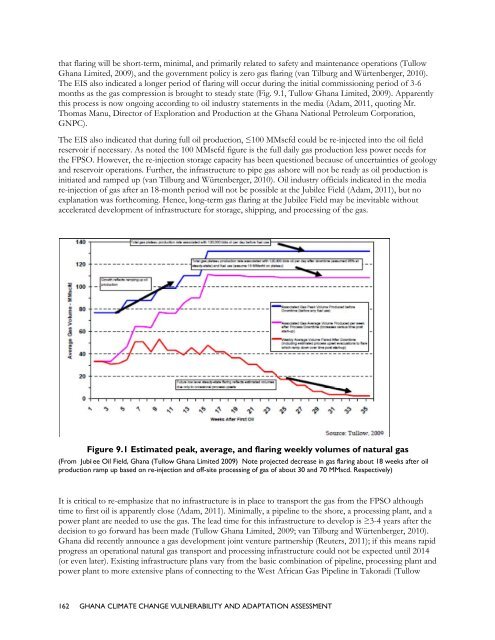ghana climate change vulnerability and adaptation assessment
ghana climate change vulnerability and adaptation assessment
ghana climate change vulnerability and adaptation assessment
- No tags were found...
Create successful ePaper yourself
Turn your PDF publications into a flip-book with our unique Google optimized e-Paper software.
that flaringwill be short-term, minimal, <strong>and</strong> primarily related to safety <strong>and</strong> maintenance operations (TullowGhana Limited, 2009), <strong>and</strong> the government policy is zero gas flaring (van Tilburg <strong>and</strong> Würtenberger, 2010).The EIS also indicated a longer period of flaring will occur during the initial commissioningperiod of 3-6months asthe gas compression is brought to steady state (Fig. 9.1, Tullow Ghana Limited, 2009). Apparentlythis process is now ongoing according to oil industry statementss in the media a (Adam, 2011, quoting Mr.Thomas Manu, Director of Exploration <strong>and</strong> Production at the Ghana National Petroleum Corporation,GNPC).The EIS also indicated that during full oil production, ≤100 MMscfd could be re-injected into the oil fieldreservoir if necessary. As noted the 100 MMscfd figure is the full daily gas production less power needs forthe FPSO. However, the re-injection storage capacity has been questioned because of uncertainties of geology<strong>and</strong> reservoir operations. Further, theinfrastructure to pipe gas ashore will not be ready as oil productionisinitiated <strong>and</strong> ramped up(van Tilburg <strong>and</strong> Würtenberger, 2010). Oil industry officials indicated in the mediare-injection of gas after an 18-month period will not be possiblee at the Jubileee Field (Adam, 2011), but noexplanation was forthcoming. Hence, long-term gas flaring at the Jubilee Fieldmay be inevitable withouttaccelerateddevelopment of infrastructure for storage, shipping, <strong>and</strong> processing of the gas.Figure 9.1 Estimated peak, average, <strong>and</strong> flaringg weekly volumes of natural gas(From Jubilee Oil Field, Ghana (Tullow Ghana Limited 2009) Note projected decrease in gas flaring about 18 weeks after oilproduction ramp up based on re-injection <strong>and</strong> off-site processing of gas of about 30 <strong>and</strong> 700 MMscd. Respectively)It is critical to re-emphasize that no infrastructure is in place to transport the gas from the FPSO althoughtime to first oil is apparently close (Adam, 2011). Minimally, a pipeline to the shore, a processing plant, <strong>and</strong> apower plant are needed to use the gas. The lead time for this infrastructure todevelop is ≥3-4 years afterthedecision togo forward has been made (Tullow Ghana Limited, 2009; van Tilburg <strong>and</strong> Würtenberger, 2010).Ghana didd recently announce a gas development joint venture partnership (Reuters, 2011); if this means rapidprogress an operational natural gas transport <strong>and</strong> processing infrastructure could not be expected until 2014(or even later). Existinginfrastructureplans vary from the basic combination of pipeline, processing plant <strong>and</strong>power plant to more extensive plans of connectingto the West African Gas Pipeline in Takoradi (Tullow162 GHANA CLIMATE CHANGE VULNERABILITY AND ADAPTATION ASSESSMENT
















